
by Kathryn Brenne

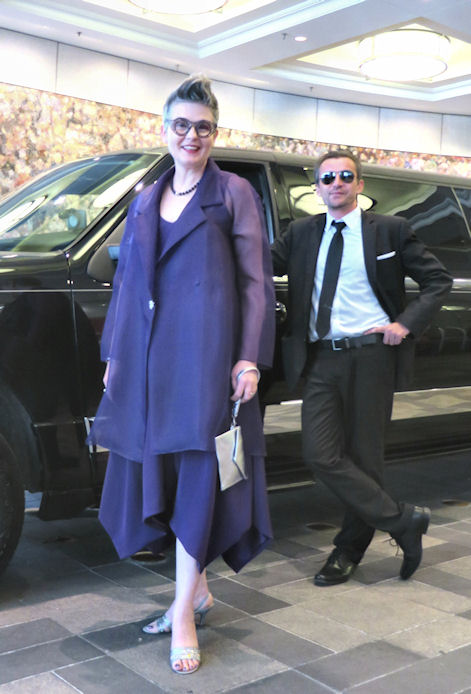
With a black tie event to attend recently, I needed a formal dress to wear. Since I had in my closet a silk organza coat dress that I had made previously, with a straight, just above the knee hemline, I was looking for a dress pattern that would work with it. The bias cut dress from Vogue 9117, with its handkerchief hemline, seemed the perfect choice to achieve an interesting look under the shorter coat dress. It was also perfect for the occasion as an elegant, twirl-worthy dress by itself, ready for the dance floor!
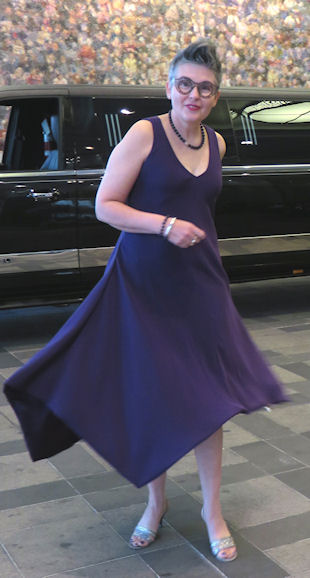

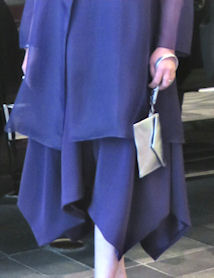
Since I had used EOS purple silk organza (color #157) for the coat dress, I ordered the same color for my new project in 4-ply silk crepe, organza and charmeuse. The silk organza was used to underline the dress and silk charmeuse to line it. EOS made it easy to match everything perfectly by offering a wide variety of silk qualities in a range of 98 colors.
Underlining a garment serves several purposes: it adds a bit more body to the fashion fabric, it prevents the fabric from wrinkling and it helps to hide the stitches when hemming and doing handwork. When underlining, the fabric chosen for the underlining is attached to the garment fabric, and is then treated as one piece of fabric as you sew your garment together.
Lining a garment provides a smooth finish, allowing the garment to slide on easily. It covers all of the seams and provides a clean and professional look to the garment. The lining is added after the outer garment is completed.
To soften the silk organza that I used for the underlining I machine-washed it with hot water several times. Each time I shook the fabric out to remove excess water, hung it to dry and pressed it, repeating these steps until the silk organza softened up. The intensity of the purple color that I chose required a few more washings than a lighter colored silk might have needed.
When working with bias seams, I like to use a 1 1/2" wide seam allowance. As you sew bias seams they can tend to stretch and narrow down; leaving a wider seam allowance gives more control as you sew the seams, resulting in a more balanced and smooth drape.
Since you will be creating 1 1/2" seam allowances later on, first remove all of the seam allowances from the tissue paper pattern. Then lay your pattern out on your fabric and thread trace around the basic pattern. Thread tracing uses a running stitch done with cotton basting thread and a long darner needle. The long needle allows you to pick up several stitches at once. Work flat on the table so as not to distort the work.

Thread trace on the actual stitching or seam line.
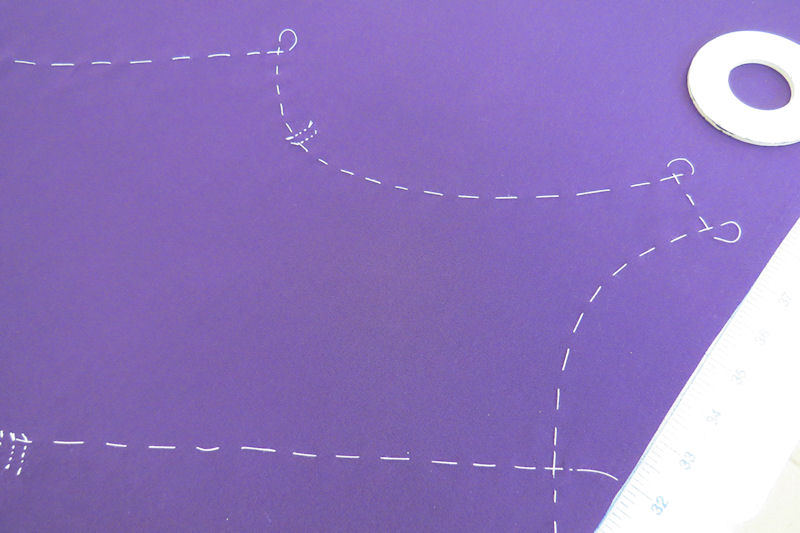

To create the silk organza underlining, lay the thread traced 4-ply silk crepe onto the washed and pressed silk organza, lining up the selvedges. Pin the two layers together just inside the thread traced lines, making sure that everything is smooth. Working flat on the table, stab stitch the two layers together just to the outside of the thread traced lines. Stab stitching is a tiny backstitch followed by a stitch forward under both layers of fabric. Stab stitch around the neckline, shoulders and armholes.
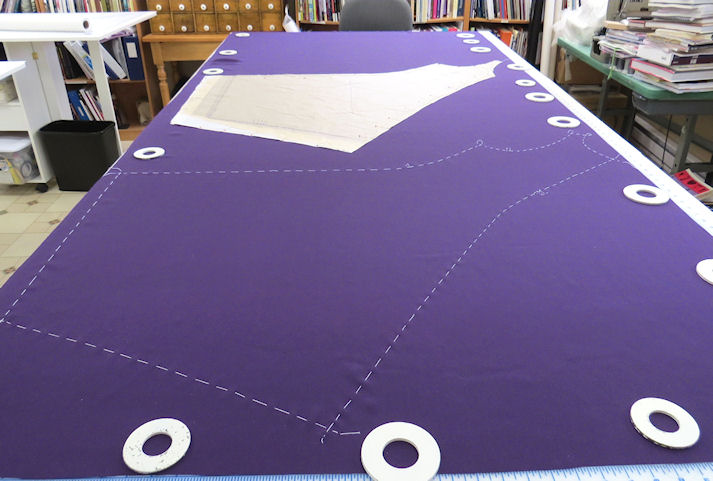
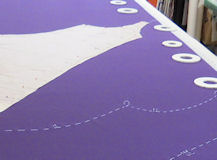

The long front, back and side seams are basted together with yellow basting cotton. I used a technique learned from Charles Kleibacker: Baste the layers together about 6 inches at a time and then cut the thread leaving long thread tails at either end. Do not knot either end of the thread. When sewing bias seams this allows the thread to stretch out.
Use a continuous running stitch to baste the two layers of fabric together along the hemline. Once all of the thread tracing, stab stitching and basting is complete, the two layers will now be treated as one. Roughly cut around the thread traced pattern pieces leaving a good 5-6" all around. This will allow for those 1 1/2" seam allowances and any alterations that maybe required*.
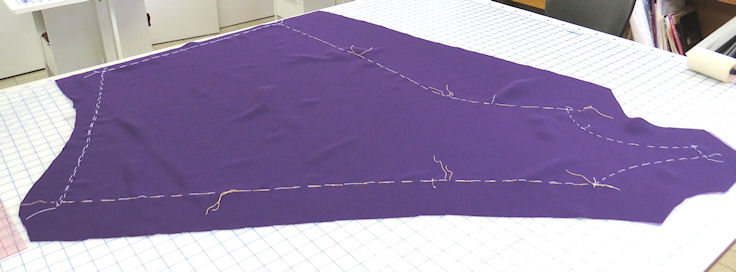
Pin the garment together along the thread traced seamlines. Baste by hand using contrast color cotton basting thread. Try the garment on for a fitting.
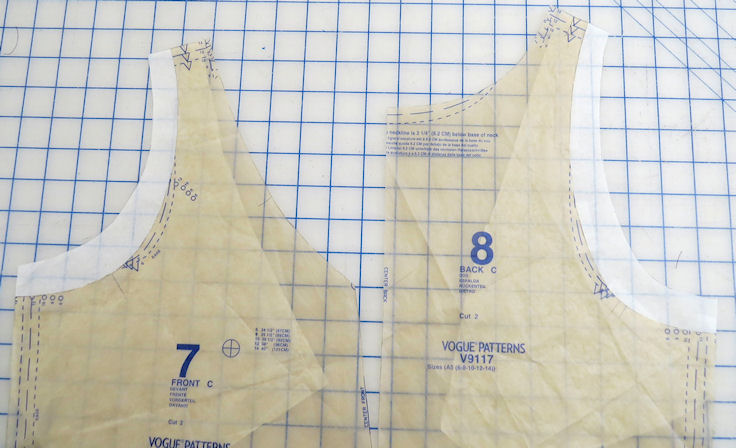
During my fitting, I found that because the dress is bias cut it stretched lengthwise, narrowing the shoulder and lowering the armhole area. I re-marked a new armhole with pins (*this is where that extra 5-6" came in handy!) and transferred this alteration to the pattern.
I took the garment apart, laid it back out flat and re-thread traced the new armhole. I removed the original stab stitching and redid the stab stitching and basting with the new seam line.
Once your alterations are made, remove the original white thread tracing from the front, back and side seams. Now, the garment is ready to be stitched together. Use a stitch length of 3mm to sew the long front, back and side seams. Pull on the seams, stretching them slightly as you sew. For the V neck, stop stitching the center front seam at the top of the seam. Do not sew beyond the V neck into the seam allowance. Sew the seams just to the outside of the basting thread. This makes it easier to remove the basting threads once the seams are sewn. Try the garment on for a second fitting.
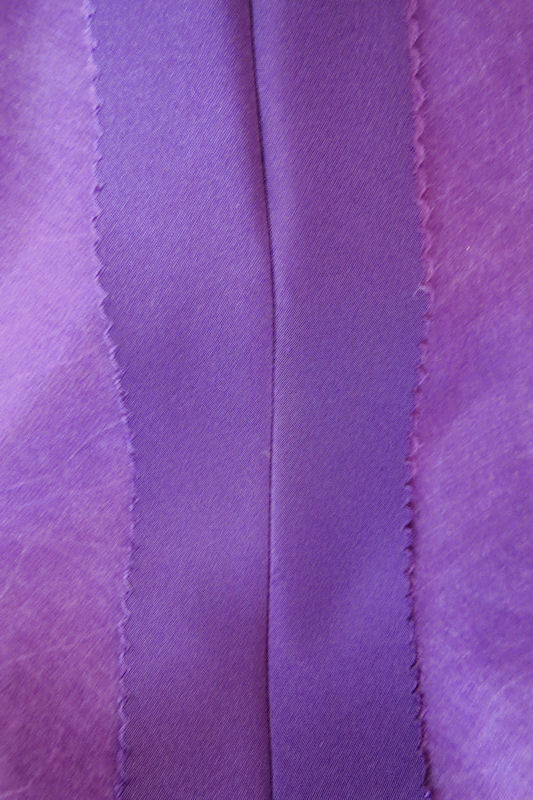
Once your fitting is complete, cut your seam allowances down to 1 1/2". Press the front, back and shoulder seams open over a seam roll. For the side seams, you may find that they hang best without creating a wrinkle if you press them open from the underarm to the waist and then press them flat for the skirt. Pink the seam allowances leaving 1 1/4" seam allowances.
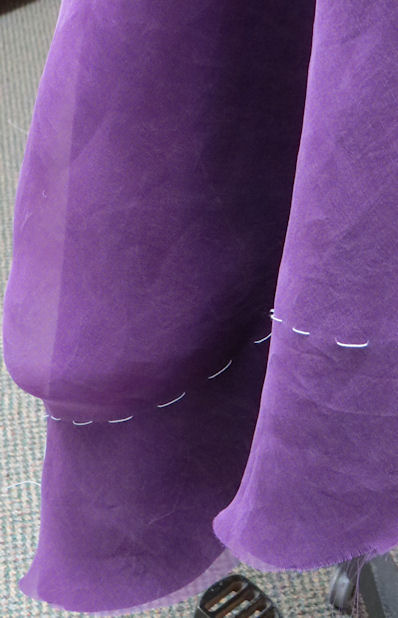
Turn the dress inside out and let it hang on a dress form overnight. You might find that the organza and the 4 ply silk hang out differently, creating a bubble in the organza underlining.
To correct this, remove the running stitch that was holding the two layers together at the hem, let the organza drop, then pin the layers together and rebaste them.
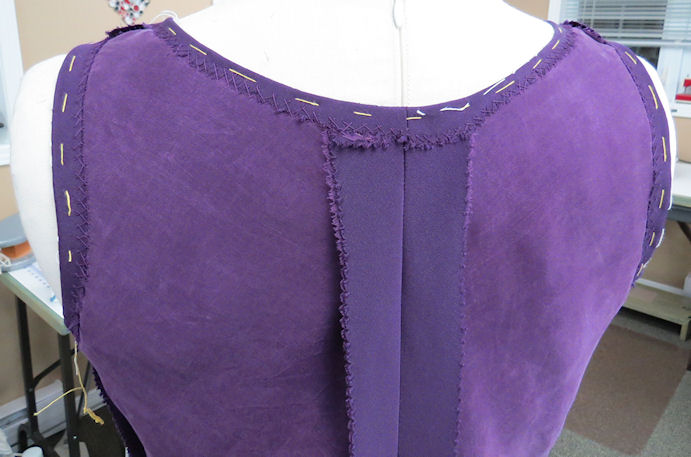
Take the garment off of the dress stand and working from the right side of the garment, fold the neck and armhole edges under. To make this easier, trim the edges down to a wide 1/2" seam allowance and clip to within 3/16" from the folded edge. Working from the right side baste the rolled edges to hold.
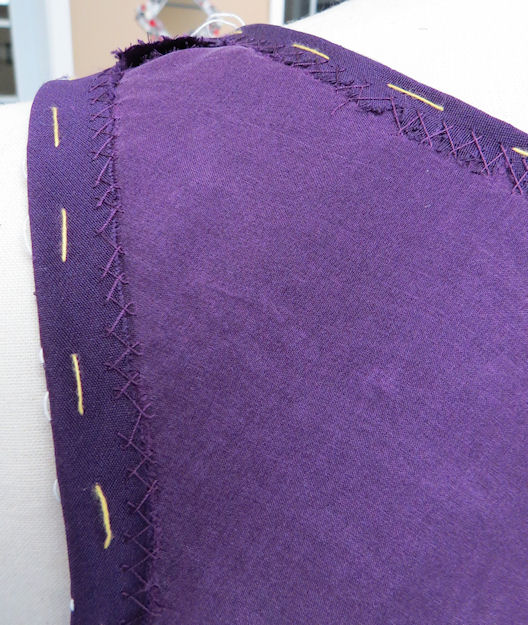
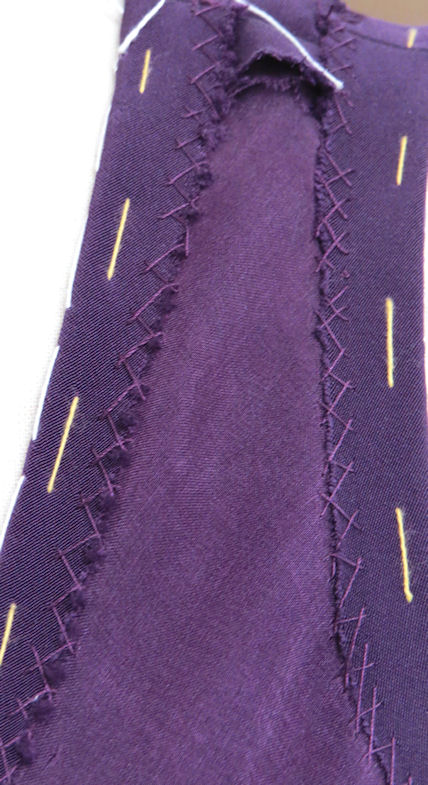
On the inside, catch stitch the edges to the silk organza underlining being careful not to pick up any of the 4-ply silk crepe.
Now we turn our attention to the hem. Again, working from the right side of the garment, fold up the hem, pin and baste close to the folded edge. Let the dress hang again overnight before checking that the hem is even. Adjust if needed. Trim the hem allowance to 2" using pinking shears. Fold the corners neatly into a miter and slip stitch.
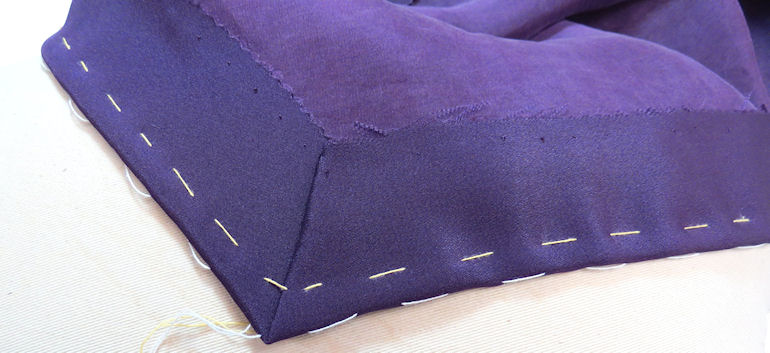
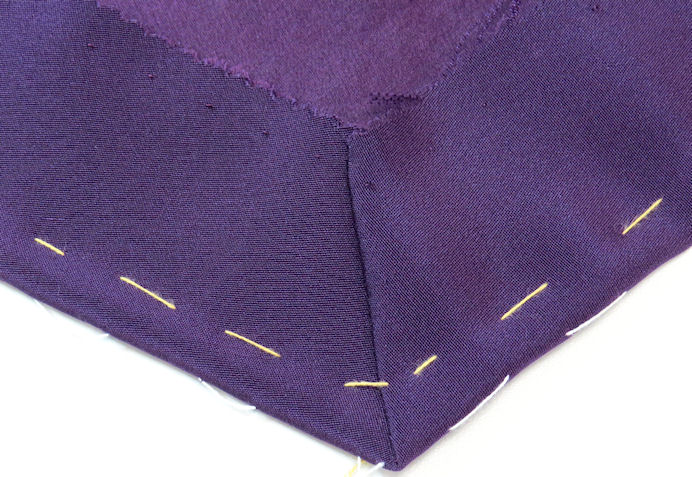
Use a hem stitch to sew the hem in place being careful to only stitch into the silk organza. The hem stitch will show as a tiny backstitch on the hem allowance. This stitch allows the hem to float. Do not press the hem flat. It should be a soft rolled edge. The basting which held the hem in place will help to define the edge.
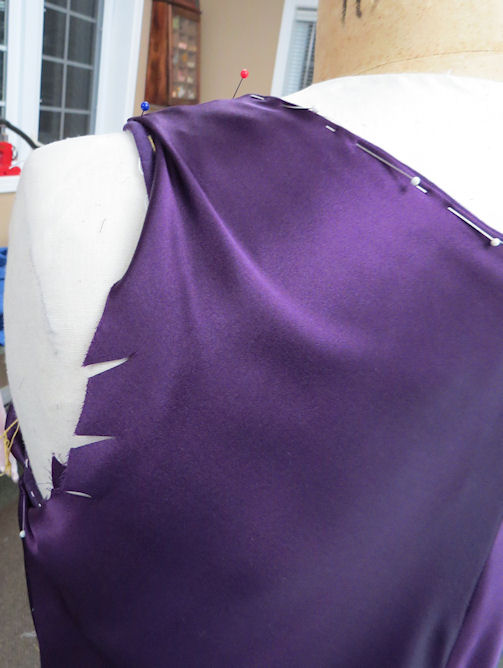
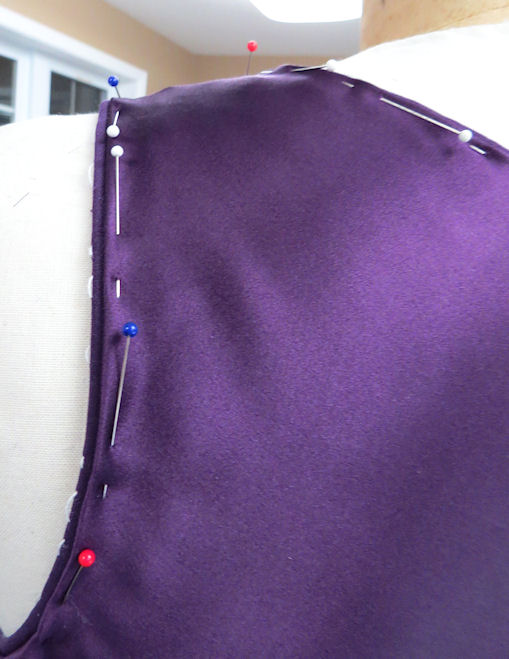
Sew the lining together leaving wide seam allowances as was done for the dress. For the V neck, stop stitching the center front seam at the top of the seam. Do not sew beyond the V neck into the seam allowance. Working with the dress inside out on the dress stand, fold under and pin the neck and armhole edges. Leave large seam allowances. Clip where necessary.
Slip stitch the edges being careful not to pick up the 4 ply silk crepe. It was very easy to accidentally pick up the 4 ply silk crepe. You might find it easier, as I did, to take a stitch and intentionally pick up the 4 ply silk and then let it fall off the needle before completing the stitch.

Fold up the lining hem so that it is a good 1/2" shorter than the dress. Pin in place, placing the pins 1 1/2" back from the edge.
Lift up the folded hem allowance of the lining and catch stitch the lining to the dress hem allowance. For more tips for working with silks, click here.

